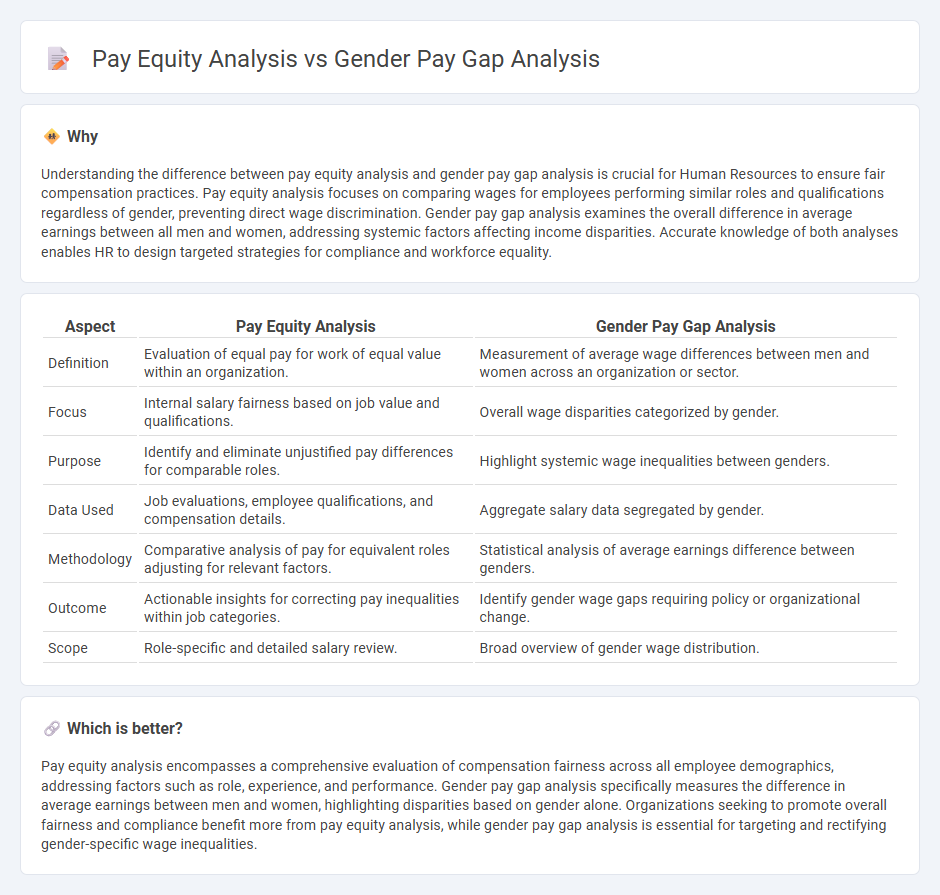
Pay equity analysis assesses fair compensation by evaluating whether employees receive equal pay for work of equal value across various demographics, focusing on job content and qualifications. Gender pay gap analysis measures the average difference in earnings between men and women, often highlighting systemic disparities in wage distribution. Explore further to understand how these analyses drive inclusive workplace strategies.
Why it is important
Understanding the difference between pay equity analysis and gender pay gap analysis is crucial for Human Resources to ensure fair compensation practices. Pay equity analysis focuses on comparing wages for employees performing similar roles and qualifications regardless of gender, preventing direct wage discrimination. Gender pay gap analysis examines the overall difference in average earnings between all men and women, addressing systemic factors affecting income disparities. Accurate knowledge of both analyses enables HR to design targeted strategies for compliance and workforce equality.
Comparison Table
| Aspect | Pay Equity Analysis | Gender Pay Gap Analysis |
|---|---|---|
| Definition | Evaluation of equal pay for work of equal value within an organization. | Measurement of average wage differences between men and women across an organization or sector. |
| Focus | Internal salary fairness based on job value and qualifications. | Overall wage disparities categorized by gender. |
| Purpose | Identify and eliminate unjustified pay differences for comparable roles. | Highlight systemic wage inequalities between genders. |
| Data Used | Job evaluations, employee qualifications, and compensation details. | Aggregate salary data segregated by gender. |
| Methodology | Comparative analysis of pay for equivalent roles adjusting for relevant factors. | Statistical analysis of average earnings difference between genders. |
| Outcome | Actionable insights for correcting pay inequalities within job categories. | Identify gender wage gaps requiring policy or organizational change. |
| Scope | Role-specific and detailed salary review. | Broad overview of gender wage distribution. |
Which is better?
Pay equity analysis encompasses a comprehensive evaluation of compensation fairness across all employee demographics, addressing factors such as role, experience, and performance. Gender pay gap analysis specifically measures the difference in average earnings between men and women, highlighting disparities based on gender alone. Organizations seeking to promote overall fairness and compliance benefit more from pay equity analysis, while gender pay gap analysis is essential for targeting and rectifying gender-specific wage inequalities.
Connection
Pay equity analysis and gender pay gap analysis both evaluate compensation disparities, focusing on fairness and equality within organizations. Pay equity analysis examines whether employees performing comparable work receive equivalent pay regardless of gender, race, or other protected characteristics. Gender pay gap analysis quantifies the average difference in earnings between men and women, highlighting systemic issues that pay equity initiatives aim to address.
Key Terms
**Gender Pay Gap Analysis:**
Gender Pay Gap Analysis measures the difference in average earnings between men and women across a workforce, highlighting overall wage disparities influenced by factors such as job roles, experience, and education. This analysis helps identify systemic issues in compensation practices but does not account for equal pay for equal work within similar roles, which is the focus of pay equity analysis. Explore more to understand how targeted strategies can address both gender pay discrepancies and fair compensation policies.
Median Gender Pay Gap
Median Gender Pay Gap analysis measures the difference in median earnings between men and women, highlighting overall disparities in pay distribution across a workforce. Pay Equity analysis delves deeper, comparing compensation for employees performing similar roles and possessing equivalent qualifications, aiming to identify unjustified pay differences. Explore more to understand how these analyses drive fair compensation practices and compliance with equal pay regulations.
Gender Representation
Gender pay gap analysis measures the average difference in earnings between men and women across an organization, highlighting overall disparities influenced by factors such as occupational segregation and gender representation within roles. Pay equity analysis goes deeper by assessing whether individuals performing similar work under comparable conditions receive equal pay, regardless of gender, focusing on eliminating discriminatory practices rather than broader population-level differences. Explore further to understand how gender representation impacts these analyses and drives fair compensation strategies.
Source and External Links
What shapes the gender pay gap? - McKinsey - Discusses how nearly 80% of the US gender pay gap is attributed to differences in work experience and career pathways.
Gender Pay Gap Statistics 2025: A Comprehensive Analysis - Provides a comprehensive overview of the global gender pay gap, highlighting regional variations and trends.
The Enduring Grip of the Gender Pay Gap - Pew Research Center - Analyzes the persistence of the gender pay gap in the US, noting minimal progress in closing it over the past two decades.
 dowidth.com
dowidth.com